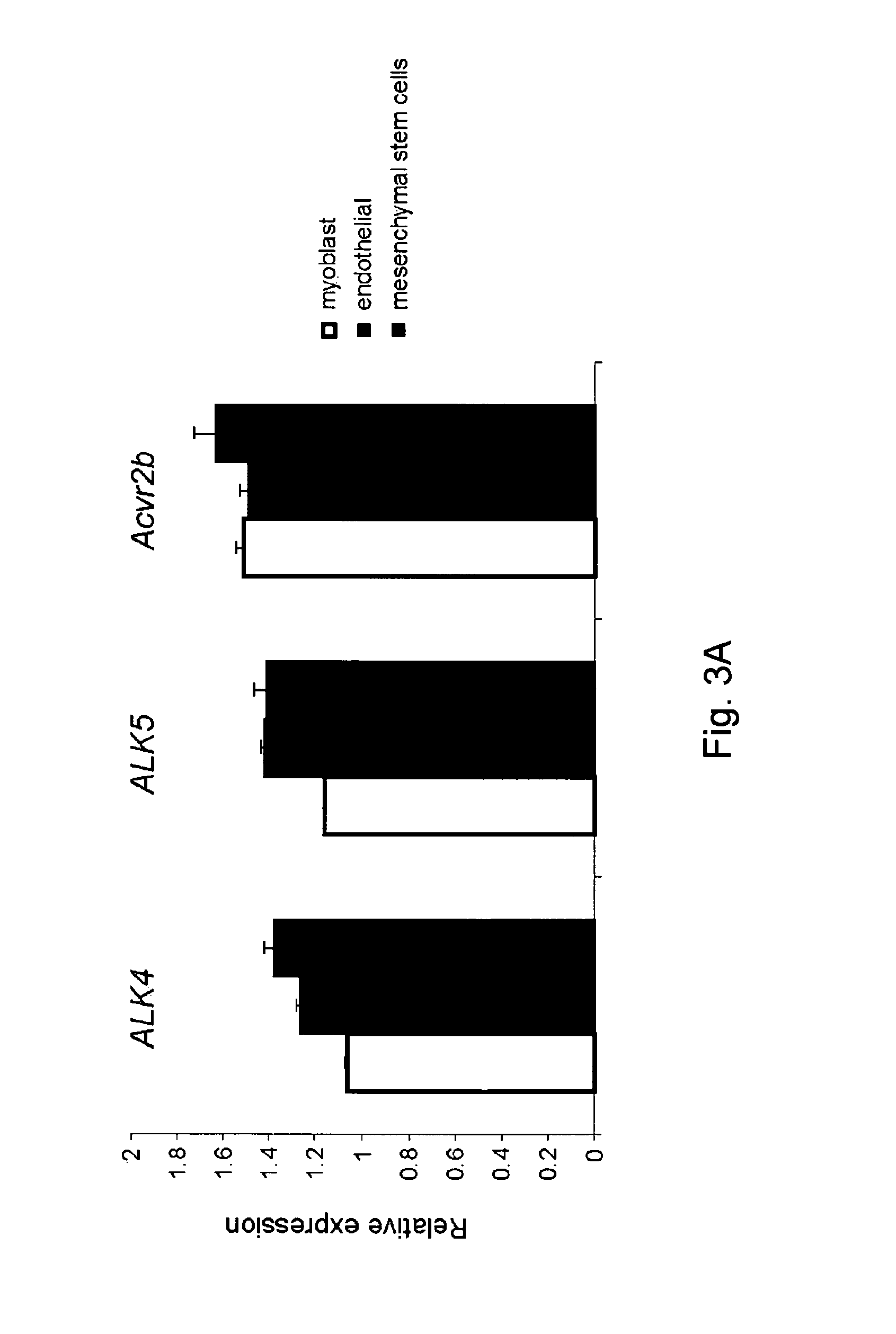Compounds and methods for altering activin receptor-like kinase signaling
a technology of activin receptor and signaling pathway, applied in the field of biotechnology, can solve the problems of complexity of the tgf-beta superfamily signaling pathway and complicate the ability to predict, and achieve the effects of modulating the splicing of the mrna, increasing muscle mass, and increasing muscle growth
- Summary
- Abstract
- Description
- Claims
- Application Information
AI Technical Summary
Benefits of technology
Problems solved by technology
Method used
Image
Examples
example 1
Selective Knockdown of ACVR1B and TGFBR1
[0165]In order to elucidate the biological effects of ACVR1B and TGFBR1, it was necessary to specifically knock down the expression of these receptors. Commercial small molecule TGFBR1 inhibitors are effective antagonists of TGFBR1 activity, but also inhibit ACVR1B and ACVR1C activities. Therefore, specific siRNA-mediated knockdown of the individual receptors was used to distinguish between the effect of ACVR1B and TGFBR1 knockdown. FIG. 1 shows a ˜60-80% knockdown of ACVR1B transcript in C3H10 T1 / 2 and C2C12 cells, respectively, using 100 nM of siRNA targeting ACVR1B (siAcvr1b). Similarly, ˜90% knockdown of TGFBR1 transcript was achieved in both cell types using the same concentration of siRNA targeting TGFBR1 (siTgfbr1). Importantly, the siRNA targeting ACVR1B showed no effect on TGFBR1 expression and vice versa.
example 2
Myostatin Signaling is Dependent on ACVR1B in the Myogenic Cells and TGFBR1 in the Non-Myogenic Cells
[0166]Next, the effect of ACVR1B or TGFBR1 knockdown on myostatin signaling in myogenic and non-myogenic cells was tested. Myogenic C2C12 cells were transiently transfected with CAGA-luciferase reporter construct, together with either the siRNA targeting ACVR1B or TGFBR1. Non-targeting siRNA and mock condition were included as controls. As shown in FIG. 2, Panel A, myostatin-induced CAGA luciferase was reduced to approximately five folds upon ACVR1B knockdown, whereas TGFBR1 knockdown had no effect compared to mock and control siRNA conditions. Surprisingly, an opposite effect was observed in the non-myogenic cells C3H10 T1 / 2 (FIG. 2, Panel B) and 3T3-L1 (not shown), in which only TGFBR1 knockdown decreased myostatin-induced CAGA luciferase to approximately two and one-half folds, whereas ACVR1B knockdown had no significant effect. Similar experiments were also performed using TGF-be...
example 3
The Effect of Co-Receptor Knockdown in Myostatin and TGF-Beta Signaling in Myogenic Vs Non-Myogenic Cells
[0168]These differences in myostatin signaling between different cells prompted the hypothesis that a presence of type III receptors for myostatin underline the ACVR1B-mediated signaling in myogenic cells and TGFBR1-mediated signaling in non-myogenic cells. Various type III receptors have been proposed to modulate TGF-beta or Activin, such as, e.g., Endoglin (Eng), Betaglycan (Tgfbr3), TDGF1 (Tdgf1) and its family Cryptic (Cfc1), as well as modulatory proteins that have been associated with myostatin binding such as Decorin (Dcn) and Perlecan (Hspg2). It was hypothesized that one or more of these proteins might be involved in mediating myostatin signaling. siRNA was transiently transfected into C2C12 cells to separately silence these receptors and quantitatively assess transcript levels 48 hours post-transfection (FIG. 3B). Decreased expression (more than 50%) of betaglycan, endo...
PUM
| Property | Measurement | Unit |
|---|---|---|
| pH | aaaaa | aaaaa |
| pH | aaaaa | aaaaa |
| temperature | aaaaa | aaaaa |
Abstract
Description
Claims
Application Information
 Login to View More
Login to View More - R&D
- Intellectual Property
- Life Sciences
- Materials
- Tech Scout
- Unparalleled Data Quality
- Higher Quality Content
- 60% Fewer Hallucinations
Browse by: Latest US Patents, China's latest patents, Technical Efficacy Thesaurus, Application Domain, Technology Topic, Popular Technical Reports.
© 2025 PatSnap. All rights reserved.Legal|Privacy policy|Modern Slavery Act Transparency Statement|Sitemap|About US| Contact US: help@patsnap.com



